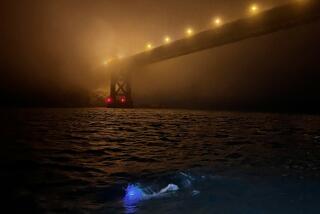Polar bear’s long swim illustrates ice melt
In one of the most dramatic signs ever documented of how shrinking Arctic sea ice impacts polar bears, researchers at the U.S. Geological Survey in Alaska have tracked a female bear that swam nine days across the deep, frigid Beaufort Sea before reaching an ice floe 426 miles offshore.
The marathon swim came at a cost: With little food likely available once she arrived, the bear lost 22% of her body weight and her year-old female cub, who set off on the journey but did not survive, the researchers said.
“Our activity data suggests that she swam constantly for nine days, without any rest. Which is pretty incredible,” said George M. Durner, a USGS zoologist and a lead author of the study, published last month in the journal Polar Biology.
“We have observed other long-distance swimming events. I don’t believe any of them have been as long in time and distance as what we observed with her,” he said. “How often does this happen? We’re trying to get a handle on that.”
Polar bears spend much of their waking lives on the shifting Arctic sea ice floes. They survive mainly on the ringed seals that are also dependent on sea ice and swim in abundance in the relatively shallow coastal waters of the continental shelf.
But sea ice has been melting dramatically in recent years, forcing polar bears during the fall open-water periods to either forage from shore or swim longer distances in search of sea ice.
Bears that retreat to land usually find little or no food there, and “typically … spend the duration fasting while they await the re-formation of ice needed to access and hunt seals,” according to a 2008 government study.
Conservation groups, the state of Alaska, the Alaska Oil and Gas Assn. and several other groups are locked in litigation in Washington, D.C., over polar bear protections and how much needs to be done to slow the pace of climate change to prevent further shrinking of their habitat.
In November, the Obama administration designated more than 187,000 square miles along the north coast of Alaska as “critical habitat” for the polar bear, but since the federal government considers the bears threatened, not endangered, there are no provisions to take dramatic steps to halt further deaths in the Beaufort and Chukchi seas.
But U.S. District Judge Emmet G. Sullivan ruled that the federal government erred in its presumptive standard that bears must be in “imminent” danger of extinction before being considered endangered. The parties are due back in court on Feb. 23.
The difference between “threatened” and the more serious “endangered” status is crucial in this case. Attorneys for the Center for Biological Diversity, Greenpeace and the Natural Resources Defense Council argue that an endangered finding will require the government to impose new controls on greenhouse gases across the country to protect the bears.
In any case, they say, the bears are imperiled.
“They’re drowning and starving now, and all the scientific studies show an incredibly high likelihood of extinction of two-thirds of the world’s polar bears in the next 40 years … and that includes all the bears in Alaska,” said Kassie Siegel, who is arguing the case for the Center for Biological Diversity.
But Alaska Gov. Sean Parnell, who is leading the charge against the Endangered Species Act protections, has said the critical-habitat designation will cost the state hundreds of millions of dollars in lost economic development and tax revenue.
Plans to develop major stockpiles of offshore oil and gas resources in the Beaufort and Chukchi seas are potentially threatened by the polar bear protection zones. Additional litigation is likely on the question of how much protection must be assured for polar bears before major new drilling can proceed.
Durner said it was clear that polar bears are spending more time in open water, and possibly on land, looking for food. Researchers conducting aerial surveys of the Beaufort and Chukchi seas for the Minerals Management Service in 2005 found 10 polar bears swimming in open Arctic water, along with four bear carcasses floating in open water, apparently drowned.
“We speculate that mortalities due to offshore swimming during late-ice or mild-ice years may be an important and unaccounted source of natural mortality, given energetic demands placed on individual bears engaged in long-distance swimming,” that study said. “We further suggest that drowning-related deaths of polar bears may increase in the future if the observed trend of regression of pack ice and/or longer open-water periods continues.”
In the case of the marathon bear, whose swim began Aug. 26, 2008, several miles east of Barrow, Alaska, researchers had captured the bear and fitted her with a GPS-equipped radio collar, along with body temperature monitoring equipment and motion sensors. She was recaptured on shore near the Canadian border on Oct. 26, a little more than two months later.
“What we have for this bear is actually a very beautiful profile of data that is very rare for any sort of wildlife, including polar bears,” Durner said. “And it allowed us to tell a story about this animal, and what she did, and what sort of conditions she may have experienced.”
She appears to have swum in an arc north and then northeast from the Beaufort Sea coast for nine days before reaching an ice floe. “She was able to get on the surface of the sea ice for a couple of days and then she went swimming again for another day. So really, she swam for 10 days, but nine days of it was sequentially,” Durner said.
The problem, he said, was that by then she was in waters 9,800 feet deep. “These waters, even though they’re ice-covered, the deep waters of the polar basin are relatively unproductive biologically when you compare them to the continental shelf, and it’s believed that seals do not use them as much as the waters of the continental shelf, which are by comparison maybe 300 feet deep.”
The bear traveled across the far-northern ice and then made a beeline for the Alaska coast, where she was recaptured and released, 107 pounds lighter than when she began.
More to Read
Sign up for Essential California
The most important California stories and recommendations in your inbox every morning.
You may occasionally receive promotional content from the Los Angeles Times.










